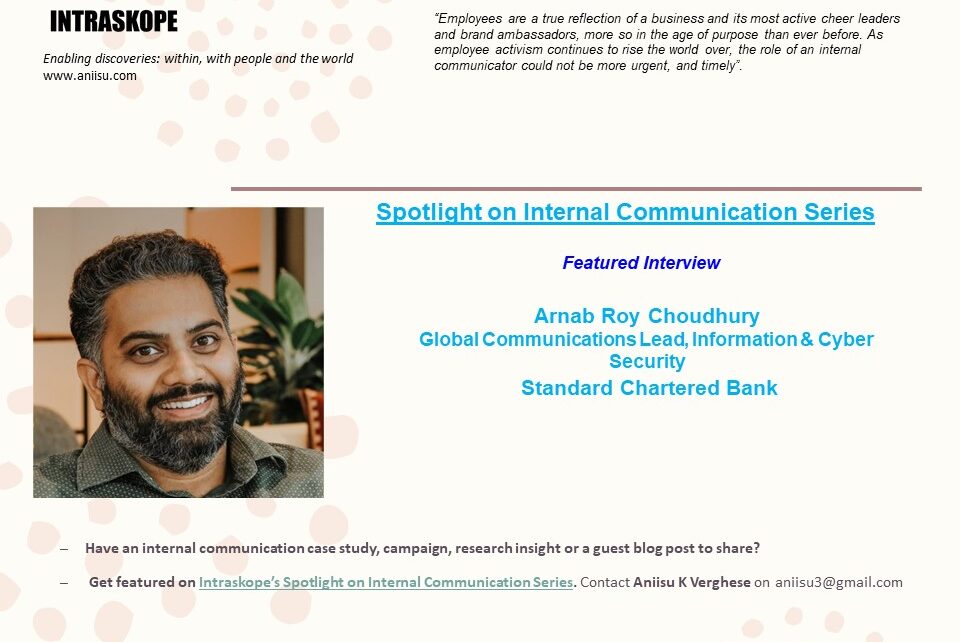Presenting the 39th edition of Intraskope’s Spotlight on Internal Communication Series featuring Arnab Roy Choudhury. Watch the complete video interview on YouTube or read the transcript below. Arnab serves as the Global Communications Lead, Information & Cyber Security for Standard Chartered Bank and is the Singapore Co-Lead for Asia Pacific Association of Communications Directors, a forum for communication leaders. With two decades of professional experience across diverse industries such as aviation, financial services, logistics, technology, realty and management consultancies, Arnab shares deep insights on internal communications from his vantage point as a communications leader in the info security space. He has experience with corporate reputation and risk management, crisis communication, issues management, employee & change communication and more. Read on gain insights.
1. What does internal communication mean to you?
Personally, internal communications is central to living the values, telling the stories, connecting with our colleagues, clients and communities through the power of credible, authentic and human storytelling. In world where disinformation thrives, internal communications when done right, builds trust from within and therefore foundational to the reputation of any organization.
2. How is it practiced in your organization?
If I have to capture in one word – I would say Human and personal. In that we have always had a strong internal communications network where the focus was on telling the benefits or impacts of an action that was always rooted in our humanity. With COVID-19 we have increased that focus to our employees & their unique diversity as we have operations across globally with an employee base covering 124 nationalities.
3. Please share an example/campaign that you are personally proud of working on and that made a significant impact to an organization in the recent past
Conduct is a very important agenda for all financial institutions and an area where it’s difficult to be truly creative because it’s a set of rules that fundamentally look at how we truly live our valued behaviors in the Bank – essentially encapsulated in the words: ‘Do the Right Thing’! The communication approach therefore almost always involved variations of talking heads through our leaders and employees sharing stories that highlighted how such behaviors helped clients, the Bank and our employees. So, when I had the opportunity to do a similar campaign, I wanted to do it differently. I was inspired by an insight shared in Sir Ken Robinson’s TED Talk. In it he talks about how children will take a go at things even if they don’t know. Misconduct in most organizations are not a pervasive culture – it’s a coping mechanism. They do something because they don’t know in a majority cases. So based on this I did a video series highlighting conversations with employee kids aged between 6-9 years where we asked them what would they do “if their friends made a poor choice” and a few other questions to highlight that even as a child you have the right answers – conduct is staying true to those feelings of doing the right thing. The unexpected use of employee kids, their genuine non-scripted responses made the video a tremendous hit with employees as it broke the clutter but more importantly presented the idea in a relatable and fun way rather than being preachy.
4. What is the biggest challenge you face while going about managing internal communication?
Attention – it’s important to take a step back and reflect how much communications an employee is being exposed to? From calls, video chats to text messages and all-consuming emails not to mention all the external stimuli. How do I ensure my message sticks with my audience when attention is in such short supply? Breaking through clutter does not mean always having a break-through idea its about creating the right context – in terms of the what’s in it for me? It doesn’t necessarily have to be elaborate. Also keep communications short is super important – under 300 words for text-based comms or use of infographics/ icons to break the monotony and keeping video under 2 min is a good guide to keep it engaging.
5. What according to you is the biggest opportunity that internal communicators have?
In times of crisis the most effective engagement for employees and stakeholders is receiving timely internal communications that reflect an honest and transparent approach from their employers. While the devastation wreaked by COVID19 needs no elaboration, for the same reasons this is also the biggest opportunity for all communicators not just internal communicators to reflect, reimagine and reset their priorities on what works and what doesn’t. A clear win I am witnessing is the window into the worlds of both our leaders and our employees – this level of access is unprecedented. And also, an opportunity for us as communicators to be truly raw, authentic and honest in our approach to communications. Ensuring that helps build the trust in our colleagues, clients and community – thereby, preparing us to come out of this, stronger together.
6. How can internal communicators add more value to the business?
I have long believed that employees are a true reflection of a business and its most active cheer leaders and brand ambassadors, more so in the age of purpose than ever before. As employee activism continues to rise the world over, the role of an internal communicator could not be more urgent, and timely. This to me is a reflection of the changing business landscape where purpose is driving the narrative for Brands and internal discussions about company policies and procedures have lately spilled into public view from how brands came out strongly against racism rearing its ugly head in America in the past few weeks – Apple, Citibank, Disney, Mastercard and even my CEO. This also means we need to be align values to action or bridge the do-action gap.
7. What skills must they have or develop?
I would say these three skills have helped me in my career 1. The ability to truly listen, and to be able to craft stories from these that both moves the business forward while making employees feel like they are part of something special. It seems easy but its infinitely more difficult – the ability to simplify and explain like you would to a five-year-old is super critical. Which also means you need to be widely read to connect the dots. 2. The ability to pick progress over perfection. It’s an additional skill which I think is particularly relevant now as we all continue to increasingly work remotely – high production values matter but not everything needs to be that. A great example of that in recent times is the video with a raw authentic account straight from a leader is that of the CEO of Marriott – Arne Sorenson. 3. Being relationship builders. As internal communicators we can’t work in vacuum. Having a pulse of the organization means tapping into your inner-Oprah to pull out the real issues and what needs to be addressed – we are as much a part of the solution as its issues. Being empathetic and mindful is as important as being open and curious.
8. What is your advice for people who are keen to join internal communication and make a career?
I don’t consider myself an expert but more an as eternal intern of life and so whatever I am saying here is not exhaustive just my reflections on what has worked for me: 1. Being self-aware – You will need to interact with a lot of people, influence them, nudge them and even at times, dig in to defend a position that is good for your colleagues, clients or community. Being self-aware is perhaps the most important skill to have. How you respond to authority, how you respond to criticism, how you manage conflict, what gives you happiness, what inspires you – if you make a conscious effort to know the answers to them you will make a better communicator – Period. 2. Being vulnerable – know that you won’t have all the answers all the time. To work in an environment of constant change with no clear path to the future is par for the course. Finding creative solutions and navigating through complexities becomes easier when you acknowledge you don’t have all the answers but are willing to work hard to get them. 3. Being business literate – You don’t have to be an expert in your chosen business industry, but to make an impact you do need to have business literate, invest in getting to understand how the business works, and what drives your business leaders. Speaking the language of your business leaders will put you leaps and bounds ahead of any other communicator out there and help you to add value to your career and your employer in a very meaningful way.
9. With COVID-19 and other crises, how must internal communications engage? What has changed or will change? Examples of how your organization has helped reassure employees and navigate the crisis as it unfolds.
Like in any crisis, the timeliness of the communications remains crucial. Therefore, having a periodic rhythm to the communications providing reliable and honest information has been central to how we approached communications – examples of this include updates on company policies as the situation changed, clarity around expectations from our employees while working remotely, greater engagement with our business leaders were all simple ways to reassure our employees make sense as the situation evolved. A lot has changed – frequency, tone, vocabulary, topics and formats and these will further evolve. What hasn’t and will not change is the simplicity and transparency of the message delivery.
10. Can you share one trend that you spot with internal communications?
Internal communications’ role within the organization has shifted significantly from being a mere promoter of values, culture or updating about current events to building endurance among the teams and to mentally supporting our employees who now live in a time of great uncertainty and complexity unlike anything since the Great Depression. We are probably experiencing a reset & reimagination of our expectations from internal communications as a function in more dramatic ways than we understand presently.
11. If there is one aspect of internal communications you would like to change, what would that be?
It’s not so much a question about internal communications but more about where it sits and who owns it within an organization. For people who ask me such questions, I have Harry Truman’s famous quote ready to respond with: “It is amazing what you can accomplish if you do not care who gets the credit.”
Liked the interview? Post your comments and share it with your network.
Keen to contribute and participate in the ongoing series on Intraskope where we put the spotlight on thought leadership, great ideas, and practical solutions? Look up the previous stories from organizations featured on the Intraskope’s Spotlight on Internal Communication Series here – BASF, Applied Materials India, Microsoft UK, Times Group, Samsung, Falabella, Brillio, UAE Exchange, Apeland, M.H. Alshaya Co, Proctor & Gamble, Infosys, SOBHA Ltd., ICICI Securities, First Advantage, CK Birla Group, TVS Motors, GE, Suzlon, Tata Sons, Percept, Knight Frank, TCS Europe, Vedanta, Oxfam, Danske Bank, Diageo, Pandora, Symantec, ISS Global Services, Telia, Thomson Reuters, IBM, General Motors, Intelligence India Software Solutions and Philips.
Intraskope (www.aniisu.com) is the first blog on internal communications in India and among the earliest around the globe. Begun in 2006, the blog has over 1000 posts on topics such as employee engagement, leadership communication and employee branding and receives thousands of visits from across the world. The blog, receives over 1,50,000 visits every month from over 50 countries globally, offers learning resources for practitioners, academicians, and students including industry workshops, research reports, and checklists.
Intraskope has been featured on leading global internal communication forums like Simply-Communicate, IC Kollectif and International Association of Business Communicators. It is hosted by Aniisu K Verghese, author of Internal Communications – Insights, Practices & Models (Sage, 2012).
If you are an internal communication leader working in a firm or a not-for-profit anywhere in the world and have an internal communication case study, campaign, research insight or a guest blog post to share please contact me on [email protected]
Here are Internal Communications resources you can use:
• Internal Communications Series: https://forms.gle/KcqmPzLwq7NQi5Km6
• Chat with Aniisu – Internal Communications: https://www.instamojo.com/intraskope/connect-with-aniisu-60-minute-personalized-d/?ref=store
• Internal Communications workshops: https://bit.ly/2zdBRl1
You can also visit my website www.intraskope.com and You Tube channel to know more about my work.


